Nine locations in Estonia, Finland and Latvia You Will Want to Shoot Your Next Film In

As versatile as Daniel Day-Lewis, the locations in the NSFA countries offer architectural and natural gems to fit various production requirements. Whether you’re after stunning natural locations, picturesque beaches, quaint villages, medieval towns, picturesque castles, Soviet obscurities, modern cityscapes, the northern lights or curious reindeer – we’ve got you covered!
Here’s a list of nine highlights Estonia, Finland and Latvia have to offer for filmmakers for the times when the world opens up again!
ESTONIA
Kreenholm Textile Factory

One of the buildings of the majestic Kreenholm manfactory. Photo by Tõnu Tunnel
On the border of Estonia and Russia, about 130 miles east of Tallinn lies Narva, a cauldron of the two cultures, once famous for its impressive Baroque city centre. It suffered significant damage in WWII destroying much of its former glory. Narva was rebuilt during the Soviet era, giving the city its prominent appearance. But a few pre-war landmarks also remain. Kreenholm Textile Factory, an English style red brick complex built over a course of decades during the second half of the 19th century – the largest and most modern factory in the Russian Empire at that time – could be one of the main attractions in the area for filmmakers. The factory, build right next to the river that separates the European Union and Russia, was closed in 2010 but the industrial colossus – a city within a city – covering over 30 hectares, is still a sight to behold and its vast derelict spaces are ideal for genre-tinged productions, be it horror, sci-fi or historic films with enough budget for providing some visual facelift.
The Islands
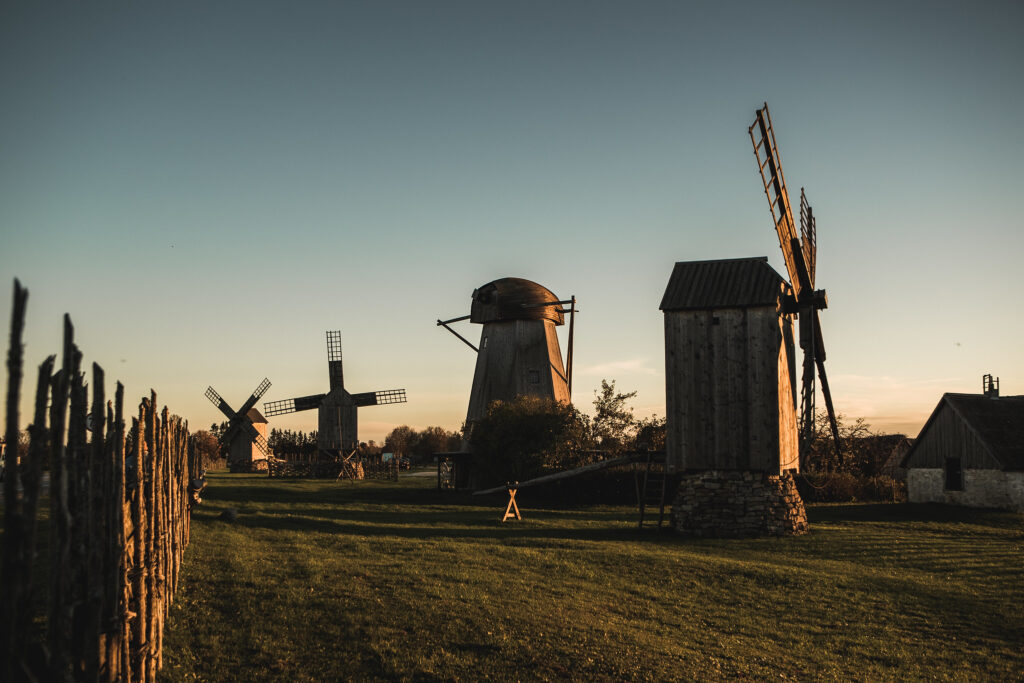
Windmills of Saaremaa. Photo by Priidu Saart
On the opposite side of Estonia is the West Estonian Archipelago with over 900 of the country’s 2222 islands. The islands are famous for their breathtaking nature: magnificent cliffs and beaches; diverse flora and fauna. Also rich in history, they offer various options for the filming locations. Travelling back in time? Looking for a folk horror atmosphere? Saaremaa, the biggest of the islands, is home to the Kuressaare Episcopal Castle, one of Estonia’s best-preserved fortresses, built during the 14th–19th century. In Muhu island, the charming Koguva village represents an exceptional example of Estonian peasant architecture with its well-kept farmhouses, rock fences and village roads. Muhu is also where St. Catherine’s church, one of the oldest in the country, is situated. It dates back to the 13th century and is notable for its tombstones with pagan symbols. After something more post-apocalyptic? Head over to neighbouring island Hiiumaa, where you’ll find spooky military bunkers dotted across the island’s coastal line – remnants of the two world wars and the Soviet era.
City of Tallinn
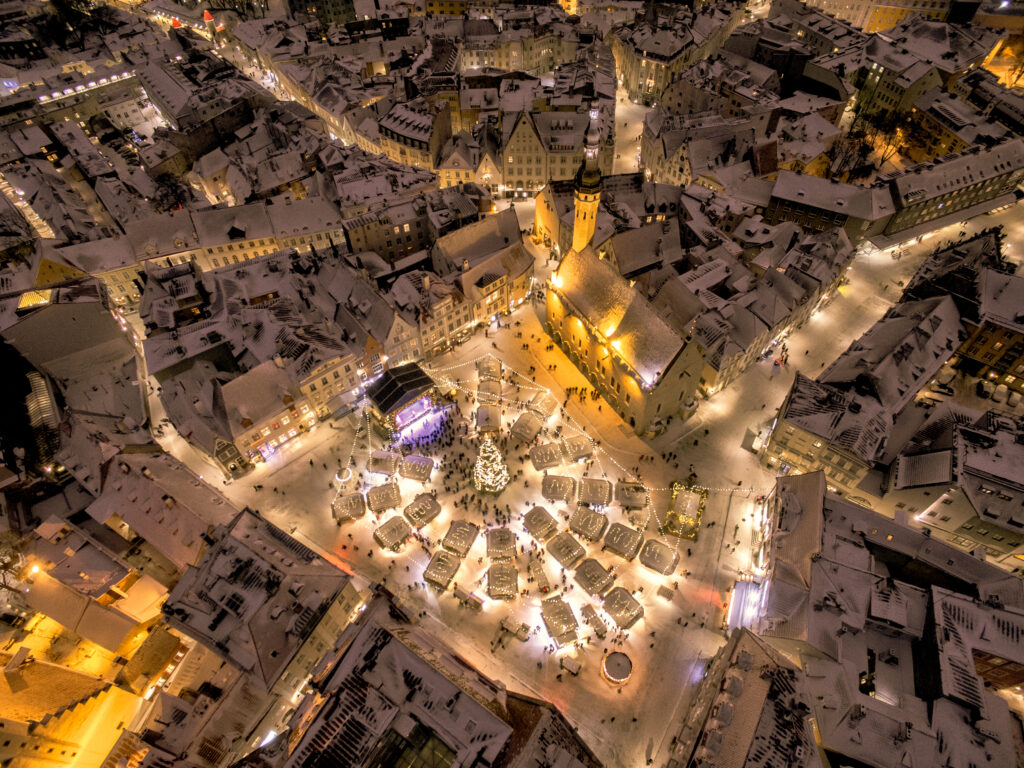
Tallinn Old Town Christmas Market. Photo by Sixten Sepp
The historic centre of the Estonian capital Tallinn has managed to maintain its medieval, UNESCO-heritage-labelled urban structure set out in the 13th century to a remarkable extent. The Old Town is an exceptionally well-preserved example of a medieval northern European trading city, complete with the last remaining Gothic Town Hall in Northern Europe making it perfect for shooting period films. Step outside the historic town walls and different worlds and production opportunities await. Soviet-era buildings and spaces also give the city its characteristics. Featured in Christopher Nolan‘s Tenet (2020), housing blocks of Lasnamäe, the brutalist mammoth Linnahall and Maarjamäe memorial complex are just a few of the examples. Some historical industrial areas, such as Rottermann Quarter or Noblessner, showcase high-quality contemporary architecture, creating unique filming locations by beautifully marrying the old.
FINLAND
Porvoo
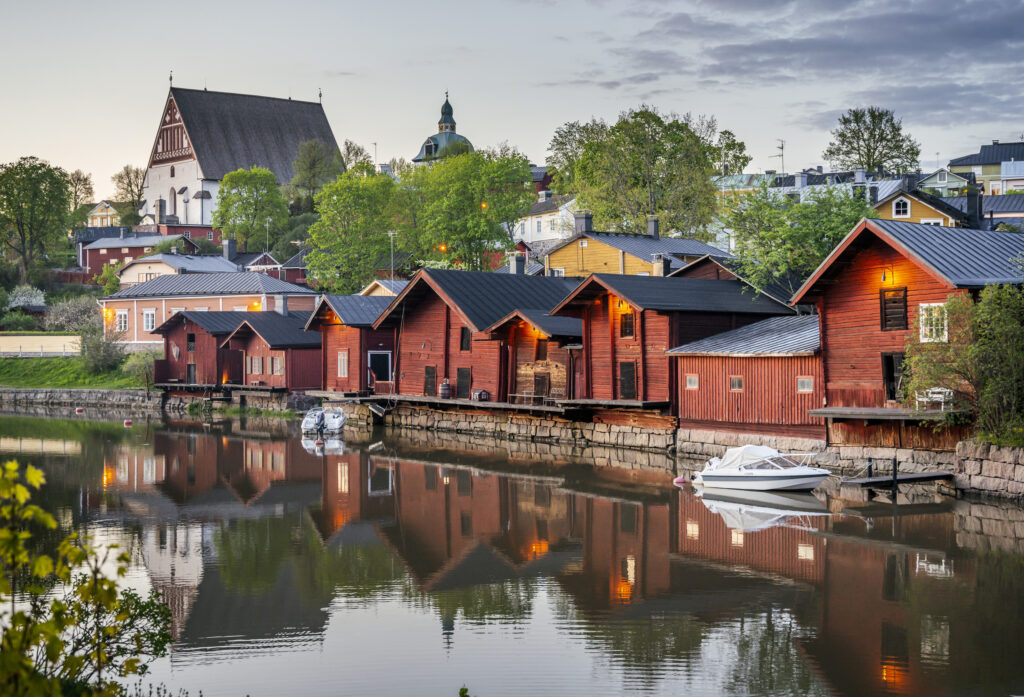
Riverside and the cathedral of Porvoo. Photo by Niko Laurila
Full of historical treasures, Finland’s second-oldest town Porvoo is known for its well-preserved colourful 18th and 19th-century wooden architecture – popular subjects with photographers. It is considered to be one of Finland’s most beautiful towns with the Cathedral – its main landmark – dating back to the 1300s and reflecting centuries of history. Porvoo is located in the river delta of Porvoonjoki and is only a short 30 miles from Helsinki making it super easy to get to. Cinematic claim to fame? It featured as Riga in the 1967 British-American espionage film Billion Dollar Brain, starring Michael Caine and in the 1997 American feature The Jackal where it stood in for Russia.
City of Helsinki
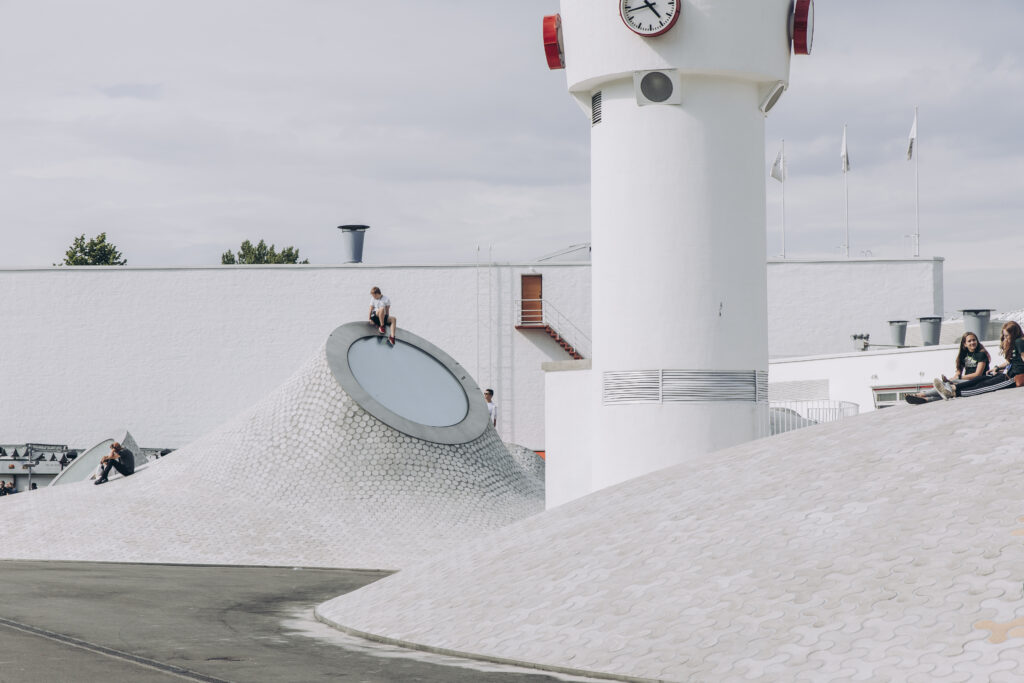
Amos Rex museum. Photo by Aleksi Poutanen
Known as a city of architecture, the maritime Helsinki contains various styles such as Neoclassicism, National Romanticism, Art Nouveau – and probably most famously, modernist buildings by legendary Alvar Aalto, such as the culture venues Finlandia Hall and the House of Culture. Helsinki also boasts some incredible contemporary architecture making it an excellent place to film, like the award-winning Amos Rex Museum and Helsinki Central Library Oodi. A short walk from the waterfront, the Neoclassical Senate Square and its surroundings make up the oldest part of the central area. Architecturally somewhere between east and west, as much as parts of it resemble Scandinavia, Helsinki has also stood in for Russian cities with the aforementioned Senate Square, representing St. Petersburg in Warren Beatty‘s 1981 historical drama Red. Also part of Helsinki is the UNESCO World Heritage site Suomenlinna – one of the world’s biggest sea fortresses and a fascinating example of 18th-century European military architecture. It stretches over six islands located at the entrance of Helsinki’s harbour and remains one of the most popular tourist attractions in the country.
Lapland

Lapland. Lapin Materiaalipankki, photo by Terhi Tuovinen
It is no secret that Finnish Lapland is a truly magical place. It has the northern lights and guaranteed snow in the winter, four distinctive seasons and white summer nights. Moreover, it is the most connected wilderness in the Arctic with a well-maintained transport network and high-quality services. Whether you’re looking for ski resorts, boglands, rivers, rapids, lakes, retro towns or Arctic fells – Finnish Lapland has it all. It is also a rare case where the vast and impressive wilderness is combined with easy accessibility as Lapland is the most accessible Arctic filming location in the world. With five airports and extensive road networks so you don’t need a helicopter to access our forests, hills, lakes, and rivers. While offering tranquil, unspoiled nature, the region is functional for productions, from the very basic support services to the luxury required for A-list stars. What’s not to love?
LATVIA
Sārnate
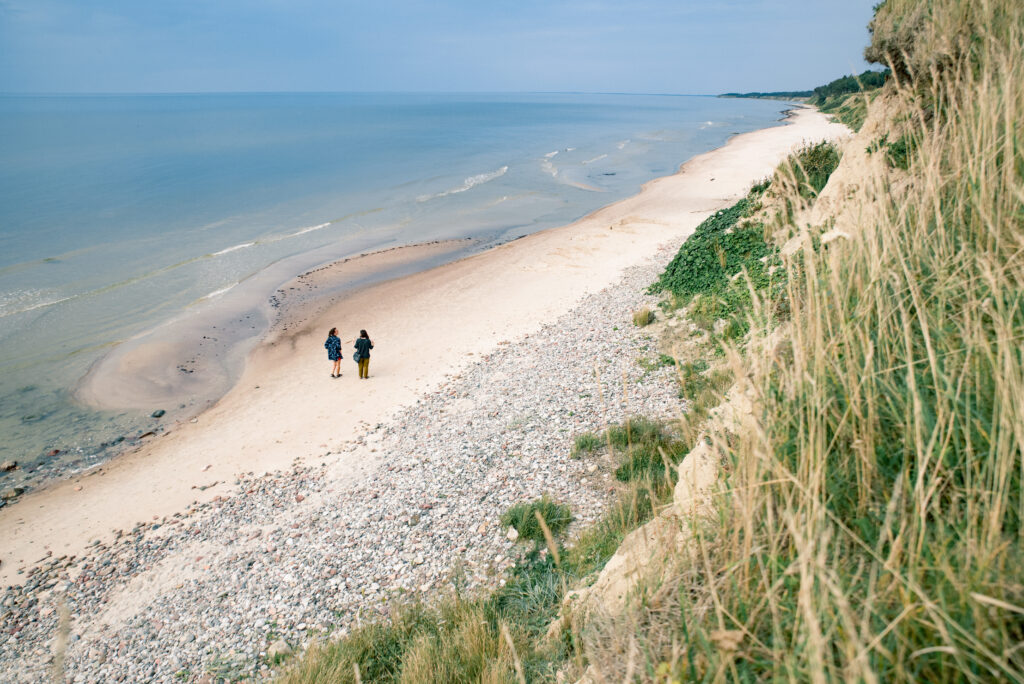
Sārnate beach strip. Photo by Jānis Bautra
In terms of the best beaches in Europe, it is the Southern part of the continent that usually comes to mind. But did you know that Latvia has about 310 miles of idyllic coastline, stretching along the Baltic Sea? Charming dunes, cliffs, contemporary coastal towns, traditional fishermen villages and wild secluded nooks can be found along the way, presenting various options for production requirements. And thanks to excellent infrastructure, no place is ever too far away. Sārnate is a village situated 101 miles from the capital city Riga. The area around it has some of the most beautiful sceneries of the Latvian seacoast with sandy, pebbly beaches, forests and breathtaking bluffs. The next time you need to shoot a natural beach scene, Latvia could be the perfect location.
Kuldiga
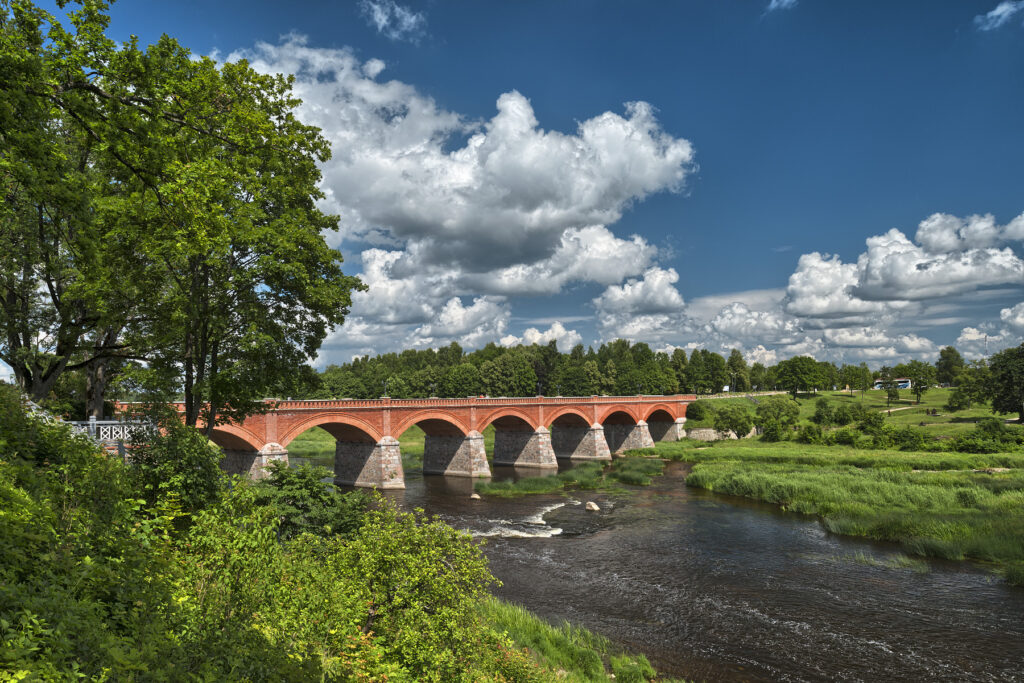
The Old Brick Bridge in Kuldiga
Drive around 30 miles east from Sārnate, and you’ll find Kuldiga, an old Hanseatic town, where the historical centre boasts with the only remaining 17th and 18th-century ensemble of its kind in the Baltic States. Considered one of the most beautiful cities in Latvia, Kuldiga old town has almost entirely preserved the historical street network from the 13th-19th centuries: historic wooden houses and narrow streets forming a harmonious and charming ensemble. Even the shop windows and signs have to keep a retro look to fit in with the historical appearance. Kuldiga also has the widest waterfall in Europe (816 feet) and one of the longest arched brick bridges on the continent – the Old Brick Bridge built in 1874.
City of Riga
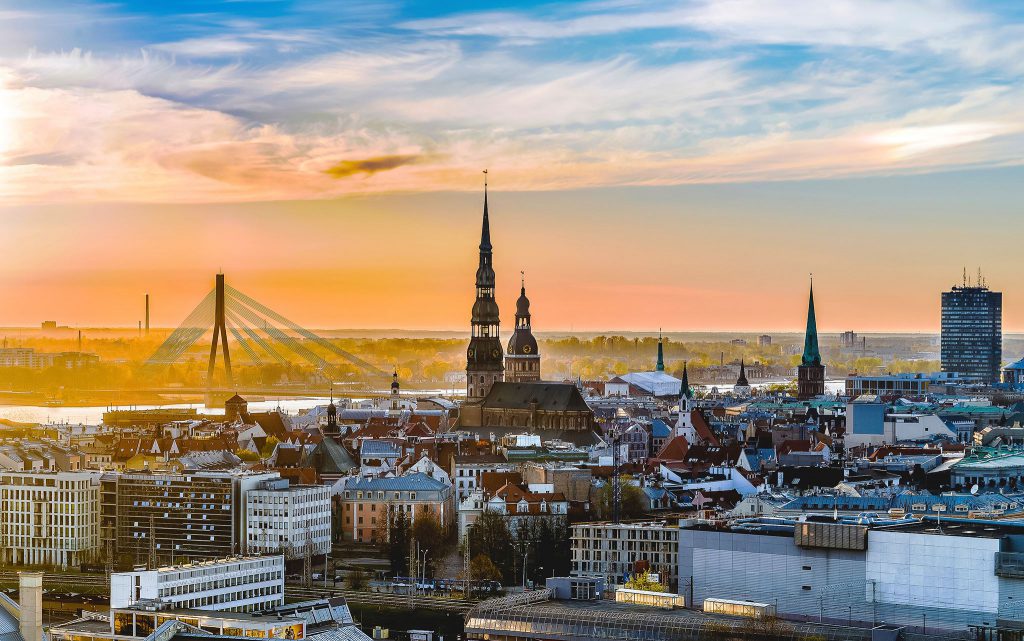
Layers of Riga. Photo by Valdis Skudre
The architecturally diverse cosmopolitan Riga, the capital city of Latvia represents architecturally most periods in European history from Middle Ages onward. Boasting with fine examples of Gothic, Baroque, Classicism, Art Nouveau and Modernism, Riga can pass for almost any city in Europe according to US producer Eleonora Granata: “This could reasonably be a location which satisfies the needs of films shooting in almost any temporal era from the last millennium: medieval, imperial, Soviet, Post-Soviet, and of course contemporary.” Connecting east and west, the past and present, Riga is truly a versatile city, having, for example, stood in for Berlin in the action thriller The Berlin File (2013); represented Paris in the 1920s in Paris Song (2018) and 20th century Vladivostok in the Korean historic musical Hero (2020).
Fitting for the season, The Riga Christmas Market, held in November-December in the picturesque Cathedral Square in the Old Town, offering that magical atmosphere perfect for the Yuletide-themed productions.